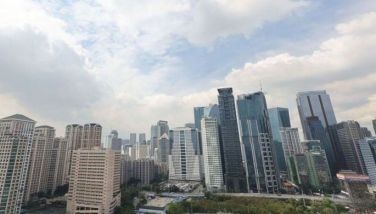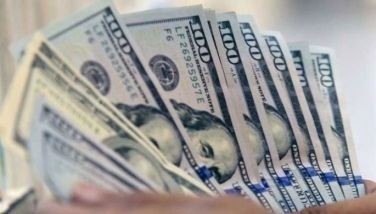Peso exchange rate: Alternative paths

Why should the peso keep appreciating? In the last week, I showed that Indonesia, Korea, and Thailand had different exchange rate experience compared to the Philippine peso. These are three high growth economies that continued to support their export sectors while adjusting to the same problems facing the peso.
Many Philippine export industries have been complaining that they could lose their market position. Some might even be forced to quit. This would be injurious to the nation given the high level of unemployment and underemployment and the widespread incidence of poverty.
“Policy discretion with a market-based exchange rate.” The exchange rate is the outcome of the forces of supply and demand for foreign exchange in an economy. Despite the dominance of market forces, policy discretion is not ruled out but is essential.
So long as the economy is allowed to function on its natural strengths, the exchange rate would approach the market solution. Economic forces would align to achieve outcomes consistent with those natural capacities.
To be effective, however, policy discretion requires the coordination of the monetary and fiscal policy. I will explain this difficult topic in the context of the peso exchange rate problem.
“Respective roles of monetary and fiscal policies.” Monetary policy is about the control of the money supply and fiscal policy about government operations on the expenditure, taxation and debt finance.
Monetary policy uses as tools the interest rate and credit instruments to set money supply. Fiscal policy works through the government’s influence on the level of total spending and production behavior of households and enterprises
What causes the peso exchange rate to strengthen are the buildup of large income flows arising from export earnings and remittances and from short term foreign money inflows seeking safe havens for their investments as well as good returns. The Philippines is seen as an attractive place to move to.
Such income flows fuel domestic monetary expansion and abets inflationary pressures. The challenge for both monetary and fiscal policy to address is to contain these pressures. When the foreign money inflows are too strong, the exchange rate appreciates. An unwanted outcome could be that the country’s export industries are undercut so that the nation’s productive efforts suffer.
Uniquely, the challenge for monetary and fiscal policy is for a coordinated policy solution to achieve a satisfactory outcome, one that would result in an exchange rate that does not penalize the export sector. For instance, a peso exchange rate in the range of 45 to 50 pesos to one dollar would be more supportive of the export sector. Given current costs, country’s export sector seeks that peso exchange rate as desirable.
“Monetary policy.” The monetary authorities would need to neutralize a lot of incoming foreign money so as not to increase the money supply. The central bank had undertaken a number of efforts to demonetize income flows.
First, it introduced a Special Deposit Arrangement (SDA) to absorb extra liquidity in the system. SDA deposits are simply parked in the central bank. The interest paid to the deposits is a pure expense for the central bank. The volume of the expansion and the participation of banks and trust funds in the system effectively wiped off extra savings. When the central bank suspected that foreign funds were entering the SDA placements in order to earn interest gains, it banned foreign deposits specifically.
Second, it relaxed rules on the purchase of foreign money and its remittance to foreign countries to encourage outflows. Similar in impact, but a different measure, was the central bank dollar loan of US$1 billion to the IMF to support the euro rescue efforts. The central bank could also help demonetize new inflows by depositing them abroad.
The central bank has in fact applied its arsenal of other tools to reduce excess liquidity. For one, it adjusted interest rates downwards in line with US Fed moves to reduce interest rates to stimulate economic recovery. This effort reduced the differentials in Philippine interest rates so that domestic rates do not become overly attractive for short-term income inflows.
Of these measures, the operations supporting SDA has taken a heavy toll. Huge losses in central bank operations have resulted from the huge pile of SDA deposits and direct foreign exchange operations. As a result, the BSP now seeks to have its capital replenished. The heavy losses reduce its ability to function more effectively using this window unless it has new capital.
“Fiscal policy branch.” From the start of the present administration, the fiscal stance was to tighten the budget in order to get the fiscal deficit down. Such action was in agreement with measures to demonetize the effects of excess foreign money in the economy. The fiscal branch however acted independently of central bank moves.
It is possible for the fiscal authorities to help the monetary authorities contain the peso appreciation. First, it could pre-pay some outstanding external debt to reduce the size of the external debt. This would have directly reduced the principal of the country’s foreign debt. It would have a powerful impact on debt reduction in a future period and would have enhanced further the budgetary picture.
Second, foreign borrowing for servicing external debt service could be canceled. Instead, the country could avail of foreign money flowing into the economy to service foreign debt. This would dramatically reduce the net capital inflows and contribute toward putting pressure to depreciate the peso. The tendency of the fiscal branch to borrow externally tentatively aggravates the foreign money inflows as the proceeds initially get transferred inward.
“Unintended outcome of BSP reform.” In fact, perhaps the independent stance of both monetary and fiscal policy might have been a perverse outcome of the BSP reform in the 1990s. It distanced the monetary from the fiscal authorities in their various actions to deal with the same problem.
As a result, the central bank was taking all the blows in dealing with the exchange setting issue. The BSP reforms of that time stripped it of the ability to issue central bank notes and to remove coordinated actions between monetary and fiscal policy.
There are other areas where fiscal and monetary coordination can benefit in pursuing the exchange rate objective. Fiscal borrowing from the public to finance temporarily the government’s current operations offers opportunities for Treasury bill operations to work with the monetary authorities.
Another case: At a time when the central bank is flush with foreign money, the Treasury cannot borrow from the central bank. Is this prohibited in the revised BSP charter or is it only imagined?
My email is: [email protected]. Visit this site for more information, feedback and commentary: http://econ.upd.edu.ph/gpsicat/
- Latest
- Trending





























